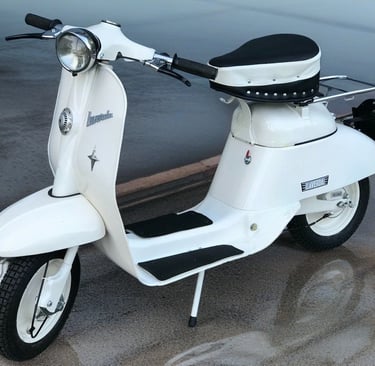Revisiting the Past: The Iconic 1961 LAVERDA 50cc Mini Scooter
The article discusses the iconic 1961 LAVERDA 50cc Mini Scooter, a small scooter designed to take advantage of tax benefits for lightweight vehicles. Despite facing competition from industry giants like Vespa and Lambretta, the scooter gained a loyal following for its performance and compact design. Laverda's commitment to quality and durability is evident in the scooter's design and engineering.
SCOOTERS ITALY LAVERDAFOUR STROKE1960'S
2/20/20242 min read


Revisiting the Past: The Iconic 1961 LAVERDA 50cc Mini Scooter
Delving into the annals of Italian motor history, we unearth a treasure from the early 1960s—the 1961 Laverda 50cc Mini Scooter. Born during the post-war era, a period marked by newfound freedom and mobility, Laverda unveiled this petite masterpiece at the 1959 Milan Show. The scooter aimed squarely at the tax-free class of single-seat ultra-lightweight vehicles, reflecting the spirit of independence that characterized the youth of that era.
Design and Engineering Marvel
Crafted with Italian finesse, the Laverda 50cc Mini Scooter was strategically designed to capitalize on the tax benefits afforded to small-capacity, single-seat scooters. Its pressed-steel monocoque chassis, reminiscent of the Vespa, housed a robust 49cc four-stroke engine beneath its compact exterior. The engine was mated to a two-speed, twist-grip-controlled transmission initially, later upgraded to a more potent three-speed variant in 1962. Simplicity and efficiency were the guiding principles behind the design, showcasing Laverda's reputation for endurance and strength through reliable and easy-to-maintain mechanical components.
Market Dynamics and Challenges
Despite its capable performance and stylish appearance, the Mini Scooter faced a challenging market dominated by industry giants like Vespa and Lambretta. Laverda's commitment to quality and durability, hallmarks of their motorcycle legacy, didn't fully translate into market dominance for the Mini Scooter. However, this diminutive wonder cultivated a loyal following enamored by its spirited performance and compact dimensions. In a bid to broaden its appeal, Laverda introduced a two-seater, 60cc model in the early '60s, infusing more power and versatility into its lineup.
Laverda's Scooter Renaissance
Renowned for crafting robust and enduring motorcycles, Laverda entered the scooter realm with an emphasis on quality and longevity. The 1961 Laverda 50cc Mini Scooter showcased a scaled-down 49cc four-stroke OHV engine, reminiscent of their larger motorbikes. This engine, renowned for its reliability, seamlessly integrated with a three-speed gearbox, transferring power to the rear wheel through a chain drive. The scooter's monocoque chassis, a fusion of individual steel pressings, embodied a perfect blend of strength and lightness.
With a power output of 1.5 bhp at 4,200 rpm, the Laverda Mini Scooter was engineered for efficiency and ease of handling, making it an ideal companion for navigating the bustling urban landscapes of the 1960s. Laverda's unwavering commitment to utilizing high-quality materials and advanced manufacturing techniques ensured that the Mini Scooter transcended mere transportation—it became a symbol of sophistication and durability in a bygone era.
